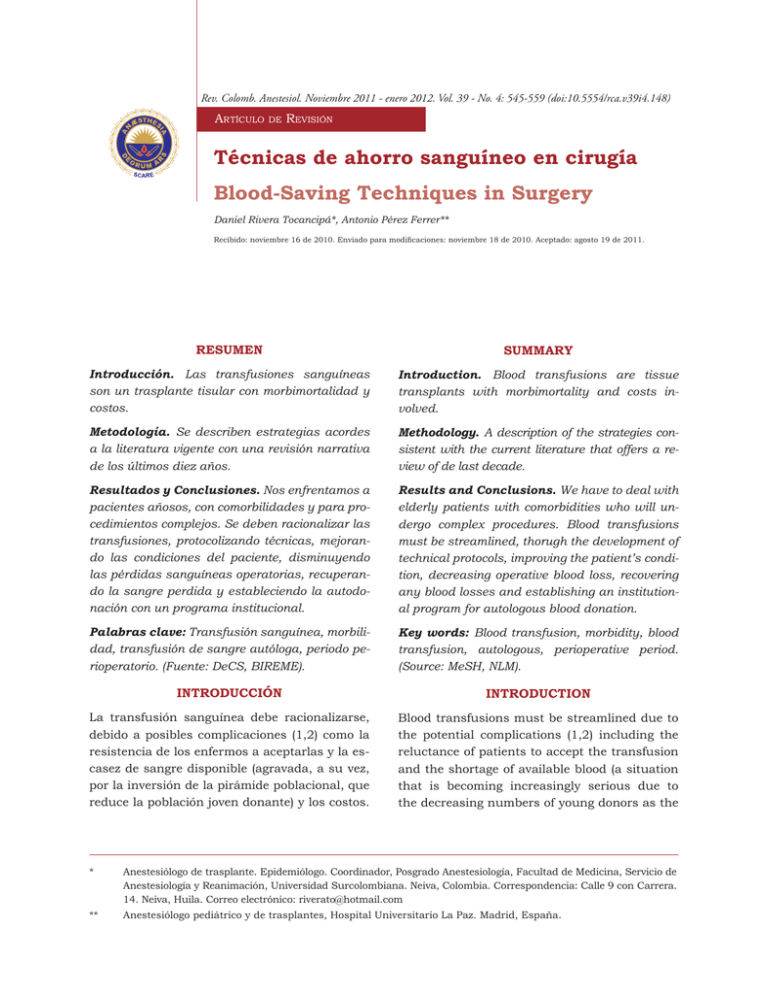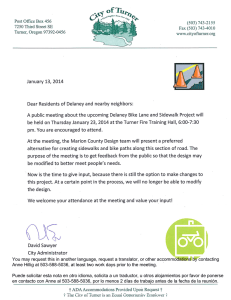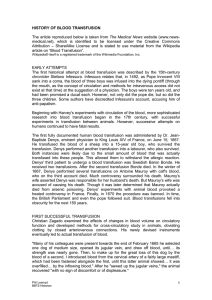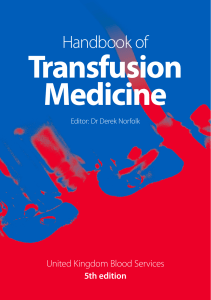técnicas de ahorro sanguíneo en cirugía blood
Anuncio

Rev. Colomb. Anestesiol. Noviembre 2011 - enero 2012. Vol. 39 - No. 4: 545-559 (doi:10.5554/rca.v39i4.148) Artículo de Revisión Técnicas de ahorro sanguíneo en cirugía Blood-Saving Techniques in Surgery Daniel Rivera Tocancipá*, Antonio Pérez Ferrer** Recibido: noviembre 16 de 2010. Enviado para modificaciones: noviembre 18 de 2010. Aceptado: agosto 19 de 2011. RESUMEN SUMMARY Introducción. Las transfusiones sanguíneas son un trasplante tisular con morbimortalidad y costos. Introduction. Blood transfusions are tissue transplants with morbimortality and costs involved. Metodología. Se describen estrategias acordes a la literatura vigente con una revisión narrativa de los últimos diez años. Methodology. A description of the strategies consistent with the current literature that offers a review of de last decade. Resultados y Conclusiones. Nos enfrentamos a pacientes añosos, con comorbilidades y para procedimientos complejos. Se deben racionalizar las transfusiones, protocolizando técnicas, mejorando las condiciones del paciente, disminuyendo las pérdidas sanguíneas operatorias, recuperando la sangre perdida y estableciendo la autodonación con un programa institucional. Results and Conclusions. We have to deal with elderly patients with comorbidities who will undergo complex procedures. Blood transfusions must be streamlined, thorugh the development of technical protocols, improving the patient’s condition, decreasing operative blood loss, recovering any blood losses and establishing an institutional program for autologous blood donation. Palabras clave: Transfusión sanguínea, morbilidad, transfusión de sangre autóloga, periodo perioperatorio. (Fuente: DeCS, BIREME). Key words: Blood transfusion, morbidity, blood transfusion, autologous, perioperative period. (Source: MeSH, NLM). Introducción Introduction La transfusión sanguínea debe racionalizarse, debido a posibles complicaciones (1,2) como la resistencia de los enfermos a aceptarlas y la escasez de sangre disponible (agravada, a su vez, por la inversión de la pirámide poblacional, que reduce la población joven donante) y los costos. Blood transfusions must be streamlined due to the potential complications (1,2) including the reluctance of patients to accept the transfusion and the shortage of available blood (a situation that is becoming increasingly serious due to the decreasing numbers of young donors as the * Anestesiólogo de trasplante. Epidemiólogo. Coordinador, Posgrado Anestesiología, Facultad de Medicina, Servicio de Anestesiología y Reanimación, Universidad Surcolombiana. Neiva, Colombia. Correspondencia: Calle 9 con Carrera. 14. Neiva, Huila. Correo electrónico: riverato@hotmail.com ** Anestesiólogo pediátrico y de trasplantes, Hospital Universitario La Paz. Madrid, España. 546 Rev. Colomb. Anestesiol. Noviembre 2011 - enero 2012. Vol. 39 - No. 4: 545-559 Para hacer frente a dichas complicaciones, se proponen las siguientes estrategias (3): 1. Elevación preoperatoria de hemoglobina (Hb). population pyramid becomes inverted), in addition to costs. In order to cope with such difficulties, the following strategies are suggested (3): 1. Raise the preoperative hemoglobin (Hb) 2. Disminuir umbral transfusional. 2. Reduce the transfusion threshold 3. Disminuir el sangrado quirúrgico. 3. Diminish surgical bleeding 4. Implementar transfusión autóloga. 4. Implementation of autologous blood transfusions 5. Difusión de estrategias. El objetivo de este artículo es rescatar y organizar estrategias clínicas básicas, sencillas y realizables en la gran mayoría de sitios de atención médica, que nos permita “ahorrar” sangre en el perioperatorio, y así disminuir la morbimortalidad y los costos. 5. Dissemination of strategies The purpose of this article is to restore and organize basic, simple and feasible clinical strategies to be adopted in most medical care facilities so as to “save” blood during the perioperative period and reduce both morbimortality and costs. Elevación preoperatoria de hemoglobina Raise the pre-op hemoglobin El paciente no debe llegar anémico a cirugía. Se considera que hay anemia cuando la Hb <13 g/ dl en hombres y <12 g/dl en mujeres, y debe estudiarse (4) (Figura 1); la mayor parte de las anemias son ferropénicas (5), y se pueden ma- The patient shouldn’t be anemic prior to surgery. Men are considered anemic if Hb <13 g/dl and <12 g/dl in women and these values must be determined (4) (Figure 1); most cases of anemia are iron-deficient (5) and can be managed with Nivel de Hb y Hcto / ¿Anemia? / ¿Anemia? Hb & Hcto Level Anemia enf. crónica / Chronic disease Anemia No Reticulocitos normal / Reticulocytes normal VCM: 80-100 / MCV: 80-100 No < 80 / < 80 > 100 / > 100 No Creatinina > 1,3? / Creatinine > 1,3? Ferritina <12 ng/ml o sat. transf. < 15 %? / Ferritin <12 ng/ml o transf. sat. < 15 %? Vit. B12 / Vit. B12 Ác. fólico / Folic acid Hematología / Hematology Descartar: / Rule out: Interconsulta: / Suplemento hierro / Iron supplementation Pérdidas sanguíneas / Blood loss Interconsult: Evaluación intestinal / Intestinal evaluation Hemólisis / Hemolisis Nefrología-hematología / Nephrology-Hematology Figura 1. Flujograma de manejo preoperatorio del paciente anémico Figure 1. Preoperative Management of Anemic Patients - Flowchart Modificado de: Pérez FA. Medicina transfusional. Madrid: Editorial Médica Panamericana, 2009. Modified from: Pérez FA. Medicina transfusional. Madrid: Editorial Médica Panamericana, 2009. Técnicas de ahorro sanguíneo en cirugía Blood-Saving Techniques in Surgery 547 nejar preoperatoriamente suplementando hierro o eritripoyetina. Si se decide transfundir, el objetivo sería elevar el aporte tisular de oxígeno aumentando el trasportador (Hb) (6). Otras anemias requieren valoración por hematología. Debe solicitarse hemograma 3 semanas antes de la cirugía. iron or erythropoietin supplementation prior to surgery. When the decision is to transfuse, the goal should be to increase the tissue oxygenation by increasing the transport medium (Hb) (6). Other types of anemia require hematological evaluation and blood tests should be performed 3 weeks prior to surgery. La anemia ferropénica (más común) típicamente es microcítica-hipocrómica (7), causada por un aumento de la demanda, pérdidas de hierro o la ingesta inadecuada de dicho mineral. Se diagnostica por volumen corpuscular medio (VCM) <100 fl, ferritina <12 mcg/L o sat. Transferrina <15 %. La anemia por enfermedad crónica (segunda causa) es típicamente hipoproliferativa (8), como en el caso del cáncer, de enfermedades autoinmunes y de insuficiencia renal crónica. Su origen es multifactorial: aumenta la síntesis de hepcidina, se inhiben la síntesis de eritropoyetina y la proliferación eritroide, y aumenta la hematofagocitosis. El diagnóstico es por laboratorio (Tabla 1). Iron deficiency anemia (the most common type of anemia) is typically microcytic – hypochromic (7) and is caused by increased iron demand, iron losses or inadequate intake of the mineral. Iron deficiency anemia is diagnosed using the mean corpuscular volume (MCV) <100 fl, ferritin <12 mcg/L or Transferrin Sat. <15 %. Anemia due to a chronic disease (second cause) is typically hypoproliferative (8), such as in cancer, autoimmune diseases and chronic renal failure. Its origin is multifactorial: increased hepcidin synthesis, inhibition of the erythropoietin synthesis and the erythroid proliferation, and increased hematophagocytosis. The diagnosis is based on laboratory tests (Table 1). Tabla 1. Tipos de anemia Table 1. Types of Anemia Anemia por déficit de hierro / Iron deficient Anemia Anemia de la enfermedad crónica / Chronic Disease Anemia Anemia mixta / Mixed Anemia ↓↓ ↓↓ ↓↓ ↑ ↓-N ↓↓ % sat. transferrina / % Transferrin Sat. ↓↓ ↓ ↓↓ Ferritina / Ferritin ↓↓ N-↑ ↓-N ↑ N ↑-N >2 <1 >2 Paraclínicos / Paraclinical Hierro / Iron Transferrina / Transferrin Rc soluble de transferrina / Soluble Transferrin Receptor Ratio de Rc soluble / log Transferrina / Soluble Receptor Ratio / log Transferrin Nota: Normal. ↑: Aumento ↓: Disminución. Modificado de: Pérez FA. Medicina transfusional. Madrid: Editorial Médica Panamericana, 2009. Note: Normal. ↑: Increase ↓: Decrease. Modified from: Pérez FA. Medicina transfusional. Madrid: Editorial Médica Panamericana, 2009. 548 Rev. Colomb. Anestesiol. Noviembre 2011 - enero 2012. Vol. 39 - No. 4: 545-559 Manejo preoperatorio de la anemia ferropénica Preoperative Management of Iron Deficient Anemia Se suplementan de 50 a 100 mg/día de hierro elemental, por vía oral. Se puede calcular el déficit corporal de hierro en miligramos, según la Fórmula de Ganzoni (9): Supplement with 50 to 100 mg/day of iron by mouth. The iron body deficit can be calculated in milligrams, according to Ganzoni’s formula (9): Peso (en kg) x (HB deseada – Hb actual) x 2,4 + depósitos de hierro. Weight (kg) x (desired HB – actual Hb) x 2.4 + iron deposits Mayores de 35 kg: Hb deseada: 15 gr/dl. Depósitos de hierro: 500 mg. Over 35 kg: desired Hb: 15 gr/dl. Iron deposits: 500 mg. Menores de 35 kg: Hb deseada: 13 gr/dl. Depósitos de hierro: 15 mg/kg. Lees than 35 kg: desired Hb: 13 gr/dl. Iron deposits: 15 mg/kg. Embarazo y postparto: Hb deseada: 12 gr/dl. Pregnancy and post-partum: desired Hb: 12 gr/ dl. Con ferritina >50 ng/ml no sumar los depó­ sitos. If ferritin >50 ng/ml do not add stores Cada unidad de GRE aporta 200 mg de hierro elemental. Each PRBC unit contributes with 200 mg of elemental iron Cuando las pérdidas crónicas superen la absorción de hierro, cuando falle el tratamiento oral o cuando exista la necesidad de corrección rápida se puede administrar hierro parenteral, teniendo en cuenta que está contraindicado en hemocromatosis, hipersensibilidad a los preparados, disfunción hepática, infección activa y saturación de transferrina > 20 % o ferritina > 400 ng/ ml (10). Parenteral iron may be administered if the chronic losses exceed the iron absorption, the oral treatment fails or whenever a fast correction is required; the contraindications for parenteral iron are hemochromatosis, hypersensitivity to the preparations, liver dysfunction, active infection and transferrin saturation >20 % or ferritin >400 ng/ml. (10) Existen varias presentaciones de hierro parenteral. El tipo sacarosa es clásico europeo y el más utilizado. El dextrano, en desuso, requiere prueba de sensibilidad por reacciones anafilácticas. El gluconato no requiere prueba, pero su baja concentración limita la reposición. El carboximaltosa es el más reciente, y requiere dilución y aplicación lenta. Unos 200 mg de hierro parenteral elevan, aproximadamente, 1 gr/dl la Hb; su efecto se inicia al día 7. La dosis, en general, va de 100 mg por dosis hasta 600 mg semanales, pero debe revisarse cada presentación, para ajustar la dosis a cada situación (11). Disminución del umbral transfusional Múltiples estudios evidencian que el umbral transfusional puede disminuirse a hemoglobina de 7 gr/dl (12) (umbral restrictivo), aun en There are several parenteral iron presentations. The saccharose type is the classic European type and the most popular. Dextrane, which is rarely used, requires a sensitivity test to determine anaphylactic reactions. Gluconate doesn’t require any tests but its low concentration limits replacement. Carboxymaltose is a more recent presentation and must be diluted and administered slowly. Around 200 mg of parenteral iron raises the Hb level by approximately 1 gr/dl; its effect begins at day 7. The usual dosing ranges from 100 mg per dose, up to 600 mg per week; however, each presentation should be reviewed individually to adjust the dose according to each particular situation (11). Lower transfusion threshold Numerous studies have shown that the transfusion threshold may be lowered to 7 gr/dl of Hb (12) (restrictive threshold), even in critical Técnicas de ahorro sanguíneo en cirugía Blood-Saving Techniques in Surgery 549 enfermos críticos (13). Un subgrupo de pacientes “coronarios” muestran resultados contradictorios, y, al parecer, toleran el umbral restrictivo si están asintomáticos (14); los sintomáticos coronarios deben tener 10-12 gr/dl de hemoglobina (15). Al contrario, un umbral tradicional “liberal” (Hb = 10 gr/dl) aumenta la mortalidad (16), los costos (17) y las infecciones postoperatorias (18), incluyendo a pacientes pediátricos (19,20). Deben recordarse, al respecto, las guías de la ASA para trasfusiones (21). Como parámetro independiente, tener una SvO2 >70 % es útil, y, quizás, evite la trasfusión (22-24). patients (13). A subgroup of “coronary” patients showed contradictory results and apparently tolerates the restrictive threshold if asymptomatic (14); the symptomatic coronary patients must have a hemoglobin level of 10-12 gr/dl (15). In contrast, a traditional “liberal” threshold (Hb = 10 gr/dl) increases mortality (16), raises costs (17) in addition to postoperative infections (18), including pediatric patients (19,20). You should keep in mind the ASA guidelines for transfusions (21). Having an SvO2 >70 % as an independent parameter may be useful and may even avoid the transfusion (22-24). La fórmula “pérdidas sanguíneas permisibles” (PSP) calcula qué tanta pérdida sanguínea se toleraría antes de optarse por transfundir (25). Siempre prima la clínica del paciente individualizando los casos (26). The “allowable blood loss” formula (ABL) estimates the tolerable blood loss before a transfusion is needed (25). The clinic of the patient always prevails, considering patients on a caseby-case basis (26). PSP = (Hcto real – Hcto umbral)/promedio Hcto x Volemia ABL = (Actual Hematocrit – Threshold Hematocrit)/average Hematocrit x Volemia Hcto Umbral: Mínimo hematocrito permitido antes de decidir una transfusión; es un concepto teórico, y se obtiene disminuyendo en un 30 % el hematocrito real del paciente, o un 20 % en patología cardiopulmonar estable, y hasta un 10 % en paciente crítico; su valor final no debe ser menor al 25 %. Threshold Hematocrit: Minimum allowable hematocrit before making the decision to transfuse; this is a theoretical concept derived from reducing the actual hematocrit of the patient by 30 %, or by 20 % in stable cardiopulmonary pathology and even by 10 % in the critical patient; the end value should be less than 25 %. Volemia (ml): Peso del paciente (kg) x 70. En prematuros se multiplica por 110; en recién nacido y neonatos, por 90; en niños, por 80; en jóvenes y adultos, por 70; en ancianos, por 65; y en mujeres ancianas, por 60. Mientras más joven y corpulento sea el paciente, mayor componente de agua corporal (volemia). Volemia (ml): Weight of the patient (kg) x 70. In pre-term babies, multiply by 110; for newborns and neonates, multiply by 90; in children x 80; in youngsters x 70; in elderly males x 65; and in elderly women x 60. The younger and stouter the patient, the higher the percentage of body water (volemia). Estrategias de disminución del sangrado quirúrgico Strategies to reduce surgical bleeding Se divide para estudio, pero en un programa de ahorro de sangre se deben complementar simultáneamente. For study purposes the strategies are segmented; however, in a blood saving program, these strategies must be complementary to one another. Estrategias farmacológicas Algunos fármacos mejoran la trombogénesis, y otros disminuyen la fibrinólisis. En general, la evidencia sugiere favorecer al ácido tranexámico, por seguridad, balance riesgo-beneficio y costos. Le siguen: el ácido aminocaproico, el complejo Pharmacological Strategies Some drugs improve the thrombogenesis and others reduce the fibrinolysis. Overall, the evidence favors tranexamic acid on account of its safety, risk-benefit ratio and costs. The second 550 Rev. Colomb. Anestesiol. Noviembre 2011 - enero 2012. Vol. 39 - No. 4: 545-559 protombínico y (si bien, en medio de una controversia costo-beneficio) el factor VII activado (27). Los efectos adversos superarían los beneficios si no se aplican en el paciente adecuado y bajo las indicaciones adecuadas: por ejemplo, el paciente con riesgo alto de sangrado y de ser transfundido. Mucho se ha aprendido de la fisiología de líquidos (28,29) y del manejo del choque hemorrágico (30), lo cual permite hacer una breve descripción de los fármacos disponibles. Factor VII activado recombinante: Dosis convencional de 80 a 120 mcg/kg. En trauma cerrado con sangrado masivo: 200 mcg/kg, seguidos de 100 mcg/kg a la hora y a las 3 horas (31). Aumenta los fenómenos tromboembólicos. En hemorragia obstétrica (32-34) y trauma (35) se describe su uso como “fuera de ficha téc­ nica”. Su costo es la principal limitante. Indicado en hemorragias en hemofílicos con inhibidor, en hemofilias adquiridas, en déficit congénito de factor VII, y en trombastenia de Glanzmann; ofrece, además, un posible beneficio en hemorragias incoercibles, pero con el tratamiento adecuado convencional, bajo las siguientes condiciones: Utilización previa de métodos quirúrgicos, embolizaciones y uso apropiado de hemoderivados, hemoglobina > 7 gr/dl, plaquetas > 50.000 x L, fibrinógeno > 0,5 gr/L, pH arterial > 7,20, temperatura > 32 °C y calcio iónico >0,08 mmol/L (36). Complejo protombínico: Contiene factores de coagulación II, VII, IX y X. Algunos preparados adicionan heparina y complejo proteína C-S. Indicado en deficiencia de factores de coagulación, en reversión de la hemorragia por anticoagulantes orales o en deficiencia de vitamina K, y en profilaxis de hemorragia intraoperatoria. Está contraindicado en alergia conocida, en trombocitopenia por heparina, en enfermedad tromboembólica arterial reciente y ante alto riesgo de CID (37). Dosis individualizada, según INR: ≥5 se aplican 30 UI/kg, y <5 aplicar 15 UI/kg a 1 ml/minuto. Acción a los 10 minutos. Usualmente debe complementarse con vitamina K (38). Ácido tranexámico: Bloquea la fibrinólisis antagonizando reversiblemente el receptor de lisina en la unión plasminógeno-fibrina, pues así choice options are aminocaproic acid, prothrombin complex and activated Factor VII, though the latter is questioned on the basis of its costbenefit ratio (27). The adverse reactions override the benefits if not used in the right patient and according to the appropriate prescription; for instance, if the patient is at high risk of bleeding and of being transfused. A lot has been learned about the physiology of fluids (28,29) and the management of hemorrhagic shock (30) to enable an overview of the available drugs. Recombinant Activated Factor VII: The conventional dose is 80 to 120 mcg/kg. For massive bleeding blunt trauma: 200 mcg/kg, followed by 100 mcg/kg after one and then three hours (31). Recombinant Activated Factor VII increases the number of thromboembolic events. In obstetric bleeding (32-34) and trauma (35) its use is “off-label”. Cost is the most important limiting factor. It is indicated for bleeding in hemophilic patients with inhibitor, in patients with acquired hemophilia, congenital Factor VII deficit and Glanzmann’s thrombasthenia; additionally, it provides a potential benefit in incoercible bleeding, as long as adequate conventional treatment is administered under the following conditions: Prior utilization of surgical approaches, embolization and use of blood products, hemoglobin >7 gr/dl, platelets >50,000 x L, fibrinogen >0.5 gr/L, arterial pH >7.20, temperature >32 °C and ionized calcium >0.08 mmol/L (36). Prothrombin Complex: Contains coagulation factors II, VII, IX y X. Some preparations include heparin and C-S protein complex. Indicated for coagulation factors deficiency, bleeding control with oral anticoagulants or in the case of vitamin K deficiency as well as prophylactic treatment intraoperative bleeding. Its use is contraindicated in cases of known allergies, in heparin thrombocytopenia, in new onset thromboembolic disease and high risk of DIC (37). Individualized INR dose: ≥5 administer 30 IU/kg, and <5 administer 15 IU/kg 1 ml/minute - Action after 10 minutes - Usually should be complemented with vitamin K (38). Tranexamic Acid: Blocks fibrinolysis through reverse antagonism of the lysine receptor at Técnicas de ahorro sanguíneo en cirugía Blood-Saving Techniques in Surgery 551 evita su transformación en plasmina. Dosis altas bloquean directamente la plasmina, y se las relaciona con episodios convulsivos. Indicado en hemorragias asociadas a hiperfibrinólisis (metrorragias, sangrado digestivo alto, sangrado dental) y profilaxis de hemorragia quirúrgica (cirugía cardiaca, cirugía ortopédica mayor, trasplante hepático). Sugerido en sangrado mayor por trauma, a dosis: 10-15 mg/kg, seguidas de infusión 1-5 mg/kg/h, hasta controlar la hemorragia (39). the plasminogen – fibrin bond, hence preventing its transformation into plasmin. High doses block plasmin directly and are associated with seizures. Indicated for bleeding associated to hyperfibrinolysis (metrorrhagia, upper GI bleeding, dental bleeding) and surgical bleeding prophylaxis (cardiac surgery, major orthopedic surgery, liver transplantation). Suggested for major bleeding in trauma at a dose of 10-15 mg/kg, followed by a 1-5 mg/kg/h infusion until the bleeding is under control (39). Ácido epsilon aminocaproico: Acción e indicaciones similares al tranexámico. Preserva la función plaquetaria evitando la degradación del receptor plaquetario glucoproteína Ib. Dosis: 100-150 mg/kg, seguidas de infusión a 15 mg/ kg/h (40). Epsilon-Aminocaproic Acid: Action and indications similar to tranexamic acid. Preserves platelet function by avoiding the degradation of the platelet glycoprotein 1b receptor. Dose: 100150 mg/kg, followed by a 15 mg/kg/h infusion (40). Desmopresina: Análogo de la vasopresina, ejerce efecto hemostático por inducción y expresión del factor Von Willebrand (FVW) endotelial activando el factor X. Útil en episodios hemorrágicos de pacientes con enfermedad de Von Willebrand, hemofilia A y defectos funcionales plaquetarios. Dosis intranasal de 150 ucg/Kg hasta los 50 kg. Para pacientes mayores de 50 kg, administrar 300 ucg/Kg. Intravenoso: 0,3 ucg/kg diluido en SSN, administrado en 30 minutos. Subcutáneo: 0,3 ucg/kg (dosis única). Como efectos adversos pueden aparecer: taquicardia, flushing, cefalea, e hiponatremia. Contraindicado en enfermedad ateroesclerótica, en trombosis venosa, en púrpura trombocitopénica y en pacientes con enfermedad de Von Willebrand tipo 2B (41). Desmopressin: Analogue of vasopressin, has a hemostatic effect through the induction and expression of the endothelial Von Willebrand Factor (VWF), activating Factor X. It can be helpful in bleeding episodes in Von Willebrand patients, in patients with hemophilia A and functional platelet defects. Intranasal dose of 150 ucg/kg up to 50 kg. In patients over 50 kg, administer 300 ucg/kg. Intravenous: 0.3 ucg/kg diluted in NSS, administered over 30 minutes. Subcutaneous: 0.3 ucg/kg (singe dose). Adverse effects include: tachycardia, flushing, headache and hyponatremia. Contraindications: atherosclerosis, venous thrombosis, thrombocytopenic purpura and Von Willebrand type 2B patients (41). No se considera la aprotinina, por estar retirada del mercado ante el supuesto aumento de mortalidad que provoca, reportado en un estudio canadiense de 2007 (42). Aprotinin is not discussed because the drug was removed from the market on the assumption that it raises mortality, as reported in a Canadian Trial in 2007 (42). Estrategias anestésicas Anesthetic Strategies Se tienen en cuenta cuatro aspectos clave: primero, hipotensión controlada, donde la tensión arterial media (TAM) disminuye sin comprometer órganos vitales, pero atenuando la presión que impulsa el sangrado en lechos cruentos. La TAM puede llevarse a 50 mmHg, y en enfermos con patología cardiopulmonar o neurológica debe ser <60 mmHg (43). Segundo, precaución Four key aspects are considered: First, controlled hypotension, meaning that the mean blood pressure (MBP) drops with no vital organ involvement but attenuating the pressure that drives bleeding in bloody beds. MBP may rise to 50 mmHg and in patients with cardiopulmonary or neurologic disease it should be <60 mmHg (43). Second: caution must be used 552 Rev. Colomb. Anestesiol. Noviembre 2011 - enero 2012. Vol. 39 - No. 4: 545-559 en administración de líquidos endovenosos, cuyo exceso puede llevar a coagulopatía dilucional (44); los “coloides”, por su parte, pueden alterar la función plaquetaria. Se aconseja mantener las presiones de llenado bajas (45). Tercero, la anestesia regional disminuye las pérdidas sanguíneas al compararla con la general y debe priorizarse (46). Y cuarto, la posición del paciente (47) con el área quirúrgica por encima del nivel cardiaco disminuye el sangrado, al disminuir la presión hidrostática relacionada con la aurícula derecha; en estos casos se debe estar atento a la posibilidad de embolia aérea. Al paciente en posición prono se le deben instaurar rollos a lo largo de ambas líneas medioclaviculares, para disminuir la presión intraabdominal y la presión sobre la vena cava, y así disminuir el sangrado. with the administration of intravenous fluids; exceeding the level of fluids may result in dilutional coagulopathy (44); “colloids” may disrupt the platelet function. The recommendation is to keep the filling pressures low (45). Third, regional anesthesia decreases any blood losses against general anesthesia and should be preferred (46). And, Fourth, the patient’s position (47) with the surgical area above the heart decreases bleeding by reducing the hydrostatic pressure in the right atria; you must be watchful for the potential or air embolism in these cases. When the patient is in prone position, pillow rolls must be placed along both mid-clavicular lines in order to reduce intraabdominal pressure and the pressure over the vena cava and hence limit the bleeding. Estrategias quirúrgicas Surgical Strategies Aplicar principios quirúrgicos halstedianos (buen trato de tejidos, estricta hemostasia, disección por planos y ligaduras selectivas) disminuye las pérdidas sanguíneas (48). El electrobisturí y otras alternativas que permitan disecar, cortar y coagular simultáneamente (como el electrocauterio, el láser de argón, y el escalpelo ultrasónico o de radiofrecuencia, así como la cirugía endoscópica o videoasistida) disminuyen el sangrado. Tanto el torniquete en cirugía de extremidades como la adrenalina en la incisión quirúrgica deberían usarse, a menos que exista alguna contraindicación (49). Follow the Halstedian surgical principles (handle tissues gently, achieve meticulous hemostasis, dissect plane by plane and selective ligatures) to reduce blood loss (48). The electric scalpel and other options to dissect, cut and achieve clotting simultaneously (such as the electrocautery, argon laser and the ultrasound or radiofrequency scalpel, as well as endoscopic or video-assisted surgery) all reduce bleeding. Both the tourniquet for limb surgery and adrenalin for surgical incision should be used, except when contraindicated (49). Hemostáticos intraoperatorios Diferentes productos pegantes de fibrina, técnicas procoagulantes tópicas y hemostáticos sobre el campo quirúrgico como método de barrera tienen evidencia cuestionable y son costosos. Se requieren estudios de calidad para recomendarlos sistemáticamente (50). Estrategias de transfusión autóloga Un paciente con adecuada Hb preoperatoria y riesgo de sangrado mayor se beneficia de la autodonación (51). Existen tres alternativas a ese respecto: La donación preoperatoria de sangre autóloga (DPS); la hemodilución normovolémica intraoperatoria (HNI); y la recuperación de san- Intraoperative Hemostatic Agents Various fibrin glue products, topical pro-coagulation techniques and hemostatic agents on the surgical field as a barrier method have questionable evidence and are costly. Good quality studies are required to systematically recommend these methods (50). Strategies for Autologous Transfusion Any patient with adequate preoperative Hb, and a higher risk of bleeding benefits from autologous blood transfusion (51). There are three options for autologous transfusion: Preoperative autologous donation (PAD); normovolemic intraoperative hemodilution (NIH); and blood recovery from the operative field (52). They Técnicas de ahorro sanguíneo en cirugía Blood-Saving Techniques in Surgery 553 gre del campo operatorio (52). Las tres difieren en cuanto a la técnica necesaria para su aplicación, los tiempos y las indicaciones por seguir en cada caso. Deben integrarse al programa de estrategias de ahorro sanguíneo: de lo contrario, su beneficio es limitado (53). Donación preoperatoria de sangre (DPS) El paciente dona sangre anticipadamente, y esta se reserva para su cirugía: así disminuyen los riesgos de la trasfusión alogénica. Con estimulación adecuada (hierro y eritropoyetina) (54) se compensa la pérdida antes de la cirugía (55). El proceso inicia a las 3 semanas precirugía; una alternativa abreviada dura 1 semana. Otra alternativa es realizar HNI (42). Con la DPS disminuyen la trasmisión de enfermedades transfusionales, la aloinmunización de eritrocitos, la necesidad de sangre alogénica, las reacciones adversas y los riesgos transfusionales; además, es compatible con el caso de pacientes que presentan autoanticuerpos. Como desventajas se tienen el riesgo de contaminación bacteriana, la incompatibilidad ABO por error humano, el hecho de que es más costosa que la sangre alogénica (no en HNI), y que puede llevar a pérdida de sangre si esta no es retransfundida (56). Con las anteriores consideraciones se pueden resumir en tres las indicaciones de DPS: Escasez de sangre alogénica (grupos sanguíneos raros o múltiples aloautoanticuerpos); cirugía con alto riesgo de sangrado masivo; y rechazo de sangre alogénica por el paciente. Condiciones para DPS 1. Cirugía con alta probabilidad de transfusión. 2. Fecha quirúrgica garantizada. 3. Tiempo mínimo entre cada donación de 1 semana; y entre la última donación y la cirugía, de 3 días. 4. Hb superior a 11 gr/dl predonación. Contraindicaciones para DPS 1. Enfermedad cardiaca grave o cianosante. 2. Infección por VIH o hepatitis C o B. all differ with regards to the technique used, the times and indications for each case. These should become part of the blood-saving strategies program; otherwise, their benefit shall be limited (53). Preoperative Autologous Donation (PAD) The patient previously donates blood and this blood is reserved for the surgical procedure; this limits the risk of allogeneic transfusion. With adequate stimulation (iron and erythropoietin) (54) any loss is compensated before surgery (55). The process begins 3 week prior to surgery; however, a faster option takes one week. Another option is to do an Normovolemic Induced Hemodilution (NIH) (42). With the use of PAD the transmission of transfusion diseases decreases, as well as the erythrocyte alloimmunization, the need for allogeneic blood, adverse reactions and any transfusion risks; furthermore, it is compatible with patients presenting autoantibodies. The disadvantages are the risk of bacterial contamination, ABO incompatibility due to human error; the fact that it is more costly than allogeneic blood (non INH) and may result in blood loss if not transfused (56). The above considerations may lead us to conclude that the indications for PAD are three: shortage of allogeneic blood (rare blood type groups or multiple allo/autoantibodies), surgery with a high risk of massive bleeding and the patient’s rejection of allogeneic blood. Conditions for PAD 1. Surgery with a high probability of transfusion 2. Definite date for the surgery 3. Minimum one-week time in between each donation, and three days between the last donation and surgery. 4. Hb pre-donation level above 11 gr/dl Contraindications for PAD 1. Serious or cyanotic heart disease 2. HIV infection or hepatitis C or B 554 Rev. Colomb. Anestesiol. Noviembre 2011 - enero 2012. Vol. 39 - No. 4: 545-559 3. Infección bacteriana activa. 3. Active bacterial infection 4. Angina inestable. 4. Unstable angina 5. Infarto de miocardio, o accidente cerebrovascular durante los últimos 6 meses. 6. Hipertensión arterial no controlada. ¿Cómo realizar la DPS? 1. Prescripción explícita por anestesiólogo: Diagnóstico, volumen solicitado y fecha quirúrgica. El volumen por extraer será, máximo, el 13 % de la volemia en adultos, y el 10 % en niños (aproximadamente, 10,5 ml/K) (57). 2. Firma del consentimiento informado por el paciente o su apoderado. 3. Valoración por el banco de sangre, para descartar contraindicaciones. 4. Extracción sanguínea y realización de pruebas para donaciones convencionales. Extraer hasta 1 unidad de GRE semanal, con intervalo mínimo de 3 días entre la última extracción y la cirugía. 5. El hierro suplementario es controvertido. Si no hay contraindicación se suministrarán 100 mg diarios, vía oral. En casos especiales, considerar el parenteral. 5. La EPO muestra su eficacia en descartar la presencia de neoplasia y enfermedad tromboembólica. Guía de DPS abreviada Se obtiene, máximo, 1 unidad de GRE 1 semana antes de cirugía; se inicia esquema abreviado de EPO y suplencia férrica si las posibilidades de sangrado mayor son altas. Se considera como alternativa la hemodilución normovolémica intraoperatoria (HNI). Eritropoyetina Recombinante Humana (EPO) Actúa en la médula ósea aumentando la proliferación, la diferenciación y la supervivencia eritroide, y disminuyendo la apoptosis celular. También actúa sobre el receptor de superficie celular para EPO (RcEPO). Con ello aumenta la resistencia a la hipoxia celular protegiendo los tejidos ante la isquemia. Al parecer, posee efecto angiogénico. 5. Myocardial infarction or cerebrovascular accident in the past 6 months 6. Uncontrolled high blood pressure How should the PAD be performed? 1. Explicit prescription by the anesthesiologist: Diagnosis, volume requested and date of surgery. The volume to be drawn must be a maximum of 13% of the volemia in adults and 10% in children (approximately 10.5 ml/K) (57). 2. Informed consent signed by the patient or his/her legal representative 3. Evaluation by the blood bank to rule out any contraindications 4. Blood extraction and testing as in a conventional blood donation. Draw up to 1 unit of PRBC per week with at least a 3-day interval between the last draw and the surgery. 5. Supplementary iron is controversial. If there is no contraindication, administer 100 mg per day orally. For special cases consider parenteral administration. 6. EPO is effective to rule any neoplasms and thromboembolic disease. Abbreviated PAD Guide Obtain a maximum of 1 unit of PRBC one week prior to surgery; the abbreviated PAD regime is started and iron supplementation when the probability of major bleeding is high. Normovolemic Intraoperative Hemodilution (NIH) can be considered an option. Recombinant Human Erythropoietin (EPO) The role of is to promote the production, differentiation and survival of erythrocytes and retards apoptosis. It also acts on the EPO cell-surface receptor (EPO-R) and hence increases the resistance to cell hypoxia by protecting the tissues against ischemia. Apparently, EPO has an angiogenic effect, a half-life of 4-9 hours when ad- Técnicas de ahorro sanguíneo en cirugía Blood-Saving Techniques in Surgery 555 Tiene una vida media de 4-9 horas administrada IV, y de 18-24 horas vía subcutánea. ministered IV and 18-24 hours if administered subcutaneously. En esquemas cortos, como los usados en DPS y HNI, prácticamente no hay efectos adversos, salvo un posible aumento de la trombosis venosa profunda en pacientes sin profilaxis antitrombótica (58). Su administración crónica, por el contrario, sí se asocia a efectos adversos como hipertensión arterial, cefalea, trombocitosis, síntomas gripales, trombosis de fístulas arteriovenosas, aplasia eritrocítica, hiperpotasemia y reacciones cutáneas. Se la contraindica en hipertensión arterial no controlada, coronariopatía, arteriopatía periférica, antecedentes de infarto de miocardio, accidente cerebrovascular, aplasia de glóbulos rojos y ausencia de tromboprofilaxis (59). In short treatment courses like those used in PAD and NIH, virtually no side effects, with the exception of a potential increase in deep venous thrombosis in patients with no anti-thrombotic prophylaxis (58). On the contrary, its chronic administration is associated with adverse effects such as high blood pressure, headache, thrombocytosis, flue-like symptoms, AV fistula thrombosis, erythrocyte aplasia, hyperpotassemia and skin reactions. EPO is contraindicated in uncontrolled high blood pressure, coronary heart disease, peripheral arteriopathy, in patients with a history of myocardial infarction, CVA, red blood cells aplasia and absence of thromboprophylaxis (59). Debe lograrse Hb de 10-12 gr/dl en adultos, y de 9,5-11 gr/dl en niños; niveles superiores predisponen a morbilidad cardiaca y aumentan la mortalidad global. No hay aprobación de EPO en pediatría como parte de DPS. In adults, the Hb level should be 10-12 gr/dl and in children 9,5-11 gr/dl; higher levels predispose to heart morbidity and increase overall mortality. EPO is not approved for pediatric patients as part of PAD. Como estrategia de ahorro sanguíneo en cirugía, la EPO es útil si hay anemia con pérdidas sanguíneas previstas importantes (<1 litro), pues con ella se logra la disminución de transfusiones sanguíneas; especialmente, en ortopedia. Se observa respuesta reticulocítica al tercer día, y aumento de Hb a la semana. EPO is a useful blood-saving strategy if the patient is anemic and important blood loss is expected (<1 liter), because it reduces the need for blood transfusions, especially in orthopedics. A reticulocyte response is observed on day three and increased Hb after one week. ¿Cómo utilizar la EPO? 1.PAD: 600 IU/K twice weekly, associated with iron, during the three weeks prior to surgery. 1. DPS: 600 UI/K dos veces semanales, asociadas a hierro, durante las 3 semanas previas a la cirugía. 2. Sin DPS, esquema convencional: 600 UI/K los días 21, 14 y 7 previos a la cirugía, y el día de la intervención. 3. Esquema corto: 300 UI/K al día, por 10 días preoperatorios, el día de la cirugía y hasta el cuarto día postoperatorio. Hemodilución normovolémica intraoperatoria (HNI) Se extrae sangre del paciente durante la inducción anestésica; se la repone con cristaloides o coloides. Así se diluyen los hematíes del enfermo, y durante el sangrado perderá menor masa How should EPO be used? 2.No PAD, conventional regime: 600 IU/K on day 21, 14 and 7 prior to surgery and the day of the operation. 3. Short regime: 300 IU/K per day for 10 days prior to surgery, on the day of surgery and up to the fourth day post-op. Normovolemic Intraoperative Hemodilution (NIH) Blood is drawn form the patient during the induction of anesthesia; it is replaced with crystalloids or colloids to dilute the patient’s red blood cells so that less erythrocyte mass will be lost during bleeding (60). Once the bleeding peak is 556 Rev. Colomb. Anestesiol. Noviembre 2011 - enero 2012. Vol. 39 - No. 4: 545-559 eritrocitaria (60). Superado el momento de mayor sangrado se reinfunde la sangre extraída, rica en hematíes. Se debe tener precaución con la cantidad y la velocidad de sangre por extraer (61). over, the erythrocyte-rich blood extracted is reinfused. Be cautious with the quantity and the rate of blood extraction (61). La sangre extraída no debe salir del quirófano, y es útil hasta por 6 horas; y debe ser refrigerada (en salas de cirugía, nunca en el banco de sangre) hasta 24 horas para el postoperatorio. Las ventajas de la HNI son similares a las de la DPS; además, la sangre no sufre “lesión por almacenamiento”, hay menor hipotermia respecto a transfundir sangre del banco, se preserva la función plaquetaria si se reinfunde antes de 6 horas, disminuye la pérdida eritrocítica operatoria (al disminuir el hematocrito), mejora la reología sanguínea por hemodilución, y es más sencilla y económica respecto a la DPS (62). The blood drawn must never leave the OR and can be used within the next six hours and must be refrigerated (in the OR, never in the blood bank) for up to 24 hours for the post-op. The advantages of NIH are similar to the advantages of PAD; furthermore, the blood does not undergo any “storage injury”, there is less hypothermia as compared to transfusing bank blood, the platelet function is preserved if reinfused within 6 hours, the loss or erythrocytes during surgery decreases (because of lower hematocrit), blood rheology improves because of hemodilution and is simpler an cheaper as compared to PAD (62). ¿Cómo realizar la HNI? How to do the NIH? 1. Revisar indicaciones y contraindicaciones. 1. Check the indications and contraindications 2. Monitorización básica intraoperatoria. 3. Canulación venosa periférica calibre grande. 4. Por una segunda punción, extraer el volumen sanguíneo (VSE) = (Hctoi – Hctof)/ promedio Hctos x Volemia (63). El Hctof es el hematocrito mínimo permitido individualizado en cada caso, y se sugiere que no sea < 25 %, ni > 70 % del hematocrito inicial. 5. Reponer cristaloides 3 ml por ml sanguíneo extraído (3:1). Si se requiere restricción hídrica, reemplazar cada ml extraído por 1 ml de coloide (1:1). 6. Mantener la sangre extraída en bolsas de banco, dentro de la sala de cirugía. 7. Autotransfundir al controlar el mayor sangrado quirúrgico, y con hemostasia garantizada. Las indicaciones, las contraindicaciones y las condiciones para la HNI son similares a las estipuladas para DPS. Recuperación sanguínea del campo operatorio Existen dispositivos “salvadores de células sanguíneas” (64) que rescatan, por aspiración, el sangrado operatorio, y una máquina heparini- 2. Basic intraoperative monitoring 3. Catheterization of a large peripheral vein 4. Through a second puncture extract the blood volume (BV) = (Hctoi – Hctof)/ average Hctof x Volemia (63). The Hctof is the individualized minimal allowable hematocrit and the recommendation is <25 %, or >70 % of the initial hematocrit. 5. Replace 3 ml of crystalloids per ml of extracted blood (3:1). When needed, restrict water intake, replace each ml extracted with 1 ml of colloid (1:1). 6. Store the extracted blood in bank bags in the OR. 7. Proceed to transfuse the autologous blood when the surgical bleeding has been controlled and with guaranteed hemostasis. The indication, contraindications and the conditions for NIH are similar to those established for PAD. Blood Recovery in the Operative Field There are “blood cells saver devices” (64) for recovering, via aspiration, any operative bleeding and then a machine heparinizes, filters, centrifuges, washes and concentrates the erythrocytes Técnicas de ahorro sanguíneo en cirugía Blood-Saving Techniques in Surgery 557 za, filtra, centrifuga, lava y concentra eritrocitos para lograr concentrados hemáticos suspendidos en suero fisiológico con hematocrito del 50 % - 70 %, con el fin de reinfundirlos al paciente. Estos dispositivos, descritos desde 1978 por Schaff (65), escapan del alcance de esta revisión, y deben consultarse en otros escritos (66). in order to achieve blood cells concentrates suspended in normal saline solution with a hematocrit between 50 % and 70 % for re-infusion into the patient. These devices have been by Schaff (65) back in 1978 (65) but are beyond the scope of this review and therefore should be looked up in other articles (66). Educación y difusión de las estrategias Education and dissemination of strategies Se requiere voluntad gerencial y colaboración interdisciplinaria para difundir, implementar, evaluar y retroalimentar las estrategias. El Comité de Transfusiones debe liderar el proceso con capacitación al personal, talleres y simulacros similares a los de la AHA en reanimación cardio-cerebro-pulmonar (67). Se requiere seguimiento semanal analizando casos exitosos y todas las transfusiones sanguíneas, buscando su pertinencia y su ajuste a los protocolos. Si el programa no se articula adecuadamente no logrará su objetivo, y, contrariamente, aumentarán las complicaciones y los costos por acciones aisladas. Management commitment and interdisciplinary collaboration are required to disseminate, implement and evaluate the strategies and provide feedback. The Transfusions Committee is expected to lead the process by providing staff training, workshops and simulations similar to those offered by the AHA in the area of cardiocerebral-pulmonary resuscitation (67). A weekly follow-up shloud be implemented, analyzing the successes and all blood transfusions to determine how relevant and adjusted to the protocols they were. A poorly articulated Program will not accomplish the goal but in contrast, will increase the number of complications and raise costs as a result of isolated actions. References 8. Cook J.D. Diagnosis and management of iron-deficiency anaemia. Best Pract Res Clin Haematol. 2005;18:319-32. 1. Goodnough LT. Risks of blood transfusion. Crit Care Med. 2003;31:(Suppl)S678-86. 2. Hébert PC. Clinical consequences of anemia and red cell. Crit Care Clin. 2004;20:225-35. 9. Ganzoni AM. Intravenous iron-dextran: Therapeutic and experimental possibilities. Schweiz Med Wochenschr. 1970;100:301-3. [Artículo en alemán]. 3. Verma S, Eisses M, Ricards M. Blood conservation strategies in pediatric anesthesia. Anesthesiol Clin. 2009;29:337-51. 10. Beris P. The use of iron to increase red cell mass. Can J Anesth. 2003;50(6 Suppl):S3-9. 4. Ferrer A. Medicina Transfusional. Madrid: Ed. Médica Panamericana; 2009. 11. Madrazo González Z, García Barrasa A, Rodríguez Lorenzo L, et al. Hierro Intravenoso. Cir Esp. 2009;86:196-203. 5. Keating EM. Preoperative evaluation and methods to reduce blood use in orthopedic surgery. Anesthesiol Clin North America. 2005;23:305-13. 6. Madjdpour C, Heindl V, Spahn DR. Risks, benefits, alternatives and indications of allogenic blood transfusion. Minerva Anestesiol. 2006;72:283-98. 7. Goodnough LT, Shander A, Spivak JL, et al. Detection, evaluation and management of anemia in the elective surgical patient. Anesth Analg. 2005;101:1858-61. 12. Kendoff D, Tomeczkowski J, Gombotz H, et al. Preoperative anemia in orthopedic surgery: Clinical impact, dianostics and teatmente. Orthopade. 2011, Sep 17 (Epub ahead of print). 13. Hébert PC, Blajchman MA, Cook DJ, et al. Do blood transfusions improve outcomes related to mechanical ventilation? Chest. 2001;119:1850-7. 558 Rev. Colomb. Anestesiol. Noviembre 2011 - enero 2012. Vol. 39 - No. 4: 545-559 14. Freeman S, DeVita M. et al. Randomized controlled trials are needed to determine appropriate blood transfusion strategies in patients with acute coronary syndromes. 2005;9:e6. 15. Rao SV, Jollis JG, Harrington RZ, et al. Relationship of blood transfusion and clinical outcomes in patients with acute coronary syndromes. JAMA. 2004;292:1555-62. 16. Shander A. Anemia in the critically ill. Crit Car Clin. 2004;159-68. 17. Izuel Rami M, Gómez Barrera M, Villar Fernández I, et al. Análisis del impacto presupuestario de la implantación de medidas de ahorro de sangre en cirugía de urgencia. Med Clin (Barcelona). 2007;128:7-11. 18. Kuriyan M, Carson JL. Anemia and clinical outcomes. Anhestesiol Clin North America. 2005;23:315-25. 19. Lacroix J, Hábert PC, Hutchinson JS, et al. Transfusion strategies for patients in pediatric intensive care units. N Engl J Med. 2007;356:1609-19. 20. Fields RG, Gencorelli FJ, Litman RS. Anesthetic management of the pediatric bleending tonsil. Pediatr Anaesth. 2010;20:982-6. 21. American Society of Anesthesiologists. Practice Guidelines for Perioperative Blood Transfusion. Anesthesiology 2006;(105):198-208. 22. Santora RJ, Moore FA. Monitoring trauma and intensive care unit resuscitation with tissue hemoglobin oxygen saturation. Crit Care. 2009;13(Suppl 5):S10. 23. Bilkovski RN, Rivers EP, Horst HM. Targeted resuscitation strategies after injury. Curr Opin Crit Care. 2004;10:529-38. 24. Napolitano LM. Resuscitation endpoints in trauma. TATM. 2005;6:8-14. 25. García MJ. Pérdidas sanguíneas permisibles, modelo exponencial. Rev. Colomb. Anestesiol. 2009;37:25562. 26. Mannucci PM, Levi M. Prevention and treatment of major blood loss. N Engl J Med. 2007;356:2301-11. 27. British Committee for Standards in Haematology, Stainsby D, MacLennan S, et al. Guidelines on the management of massive blood loss. Br J Haematol. 2006;135:634-41. 28. Hahn RG. Volume kinetics for infusion fluids. Anesthesiology. 2010;113:470-81. 29. Chappell D, Jacob M, Hofmann-Kiefer K, et al. A rational approach to perioperative fluid management. Anesthesiology. 2008;109:723-40. 30. Ahonen J, Stefanovic V, Lassila R. Management of post-partum haemorrhage. Acta Anaesthesiol Scand. 2010;54:1164-78. 31. Levi M, Levy JH, Andersen HF, et al. Safety of recombinant activated factor VII in randomized clinical trials. N Engl J Med. 2010;363:1791-800. 32. McLintock C. Obstetric haemorrhage. Thromb Res. 2009;123(Suppl 2):S30-4. 33. Breathnach F, Geary M. Uterine atony: definition, prevention, nonsurgical management, and uterine tamponade. Semin Perinatol. 2009;33:82-7. 34. Burtelow M, Riley E, Druzin M, et al. How we treat: management of life-threatening primary postpartum hemorrhage with a standardized massive transfusion protocol. Transfusion. 2007;47:1564-72. 35. Aledort LM. Off-label use of recombinant activated factor VII - safe or not safe? N Engl J Med. 2010;363:1853-4. 36. Hause CJ, Boffard K, Dutton R, et al. Results of the control trial: efficacy and safety of recombinant activated factor VII in the management of refractory traumatic hemorrhage. J Trauma. 2010;69:489-500. 37. Schick KS, Fertmann JM, Jauch KW, et al. Prothrombin complex concentrate in surgical patients: retrospective evaluation of vitamin K antagonist reversal and treatment of severe bleeding. Crit Care. 2009;13:R191. 38. Leissinger CA, Blatt PM, Hoots WK, et al. Role of prothrombin complex concentrates in reversing warfarin anticoagulation: a review of the literature. Am J Hematol. 2008;83:137-43. 39. CRASH-2 collaborators, Roberts I, Shakur H, et al. The importance of early treatment with tranexamic acid in bleeding trauma patients: an exploratory analysis of the CRASH-2 randomised controlled trial. Lancet. 2011;377(9771):1096-101. 40. Henry D, Carless P, Fergusson D, et al. The safety of aprotinin and lysine-derived antifibrinolytic drugs in cardiac surgery: a meta-analysis. CMAJ. 2009;180:183-93. 41. Ozgönenel B, Rajpurkar M, Lusher JM. How do you treat bleeding disorders with desmopressin? Postgrad Med J. 2007;83:159-63. 42. McEvoy MD, Reeves ST, Reves JG, et al. Aprotinin in cardiac surgery: a review of conventional and novel mechanisms of action. Anesth Analg. 2007;105:94962. 43. Purdham RS. Reduced blood loss with hemodynamic stability during controlled hypotensive anesthesia for Lefort I maxillary osteotomy using high dose fentanyl: a retrospective study. CRNA. 1996;7:33-46. 44. Carrillo-Esper R, Sánchez-García R. Coagulopatía dilucional. Revista Mexicana de Anestesiología. 2008; 31Supl 1:S129-31. Técnicas de ahorro sanguíneo en cirugía Blood-Saving Techniques in Surgery 559 45. Jones RM, Moulton CE, Hardy KJ. Central venous pressure and its effect on blood loss during liver resection. Br J Surg. 1998;85:1058-60. 46. Scott NB, Kehlet H. Regional anaesthesia and surgical morbidity. Br J Surg. 1988;75:299-304. 47. Schonauer C, Bocchetti A, Barbagallo G, et al. Positioning on surgical table. Eur Spine J. 2004;13(Suppl 1):S50-5. 48. Jiménez JCE. Recomendaciones medicoquirúrgicas para disminuir el uso y pérdida de derivados sanguíneos. Rev Colomb Cir. 2005;20:105-17. 49. Kragh JF, O Neill ML, Beebe DF, et al. Survey of the indications for use of emergency tourniquets. J Spec Oper Med. 2011;11:30-8. 50. Perkins JG, Cap AP, Weiss BM, et al. Massive transfusion and nonsurgical hemostatic agents. Crit Care Med. 2008;36(7 Suppl):S325-39. 51. Spahn DR, Casutt M. Eliminating blood ttransfusions: new aspects and perspective. Anesthesiology. 2000;93:242-55. 52. Goodnough LT. Autologous blood donation. Anestesiol Clin North America. 2005;23:263-70. 53. Napier JA, Bruce M, Chapman J, et al. Guidelines for autologus transfusion II. Perioperative haemodilution and cell salvage. Br J Anaesth. 1997;78:76871. 54. Bisbe E, Sáez M, Nomen N, et al. Eritropoyetina sólo o como coadyuvante del programa de donación de sangre autóloga en cirugía ortopédica mayor. Rev Esp Anestesiol Reanim. 2003;50:395-400. 55. Singbartl K, Innerhofer P, Radvan J, et al. Hemostasis and hemodilution: a quantitative mathematical guide for clinical practice. Anesth Analg. 2003;96:929-35. 56. Singbartl G. Pre-operative autologous blood donation: clinical parameters and efficacy. Blood Transfus. 2011;9:10-8. 58. Muñoz Gómez M, Naveira Abeigón E, Campos Garrigues A, et al. Usefulness of autologous transfusion and erythropoietin in surgical and critically ill patients. Med Clin (Barc). 2003;120:357-8. 59. Muñoz M, Leal Noval SR, García Erce JA. ¿Eritropoyetina humana recombinante, ¿Una alternativa válida para el tratamiento de la anemia del paciente crítico? Med Clin (Barc). 2009;132:749-55. 60. van der Linden P, De Hert S, Mathieu N, et al. Tolerance of acute isovolemic hemodilution. Effect of anesthetic depth. Anesthesiology. 2003;99:97-104. 61. Bourke DL, Smith TC. Estimating allowable hemodilution. Anesthesiology. 1974;41:609-12. 62. Bryson GL, Laupacis A, Wells GA. Does acute normovolemic hemodilution reduce perioperative allogeneic transfusion? A metaanalysis. The International Study of Perioperative Transfusion. Anesth Analg. 1998;86:9-15. 63. Jiménez DF, Barone CM. Intraoperative autologous blood transfusion in the surgical correction of craniosynostosis. Neurosurgery. 1995;37:1075-9. 64. Waters JH. Red blood cell recovery and reinfusion. Anestesiol Clin North America. 2005;23:283-94. 65. Schaff HV, Hauer JM, Bell WR, et al. Autotrasfusion of shed mediastinal blood after cardiac surgery: a prospective study. J Thorac Cardiovasc Surg. 1978;75:632-41. 66. Muñoz Gómez M, García Vallejo J, López-Andrade Jurado A, et al. Autotrasfusion after orthopedic surgery: Analysis of quality, safety and efficacy of salvaged shed blood. Rev Esp Anestesiol Reanim. 2001;48:131-40. 67. Bhanji F, Mancini ME, Sinz E, et al. Part 16: education, implementation, and teams: 2010 American Heart Association guidelines for cardiopulmonary resuscitation and emergency cardiovascular care. Circulation. 2010;122(Suppl 3):S920-33. 57. Brecher ME, Rosenfeld M. Mathematical and computer modelling of acute normovolemic hemodilution. Transfusion. 1994;34:176-9. Conflicto de intereses: Ninguno declarado. Financiación: Los autores niegan cualquier relación con la industria que haya suscitado la elaboración de este manuscrito.









